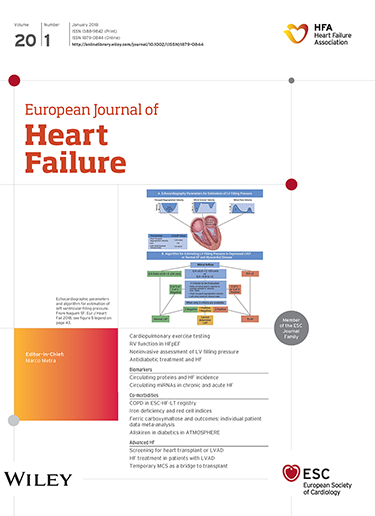Heart failure after myocardial infarction: Glass emptier than full
IF 16.9
1区 医学
Q1 CARDIAC & CARDIOVASCULAR SYSTEMS
引用次数: 2
Abstract
Heart failure (HF) is an ominous and common complication following an acute myocardial infarction (MI). In fact, there is no single greater predictor of mortality following an MI than acute symptoms of HF.1 Once the acute period surrounding an MI is past, the risk continues, and an estimated 12–15% of all patients experiencing an MI will develop HF requiring hospitalization within a year. This risk appears to be especially high for patients who are older, female, who have reduced ejection fraction or acute congestion at the time of MI, and/or in those with certain comorbidities such as type 2 diabetes or chronic kidney disease.1 Once patients develop HF following an MI, their risk of death is markedly elevated. The risk of death associated with HF is substantially higher than the risk of death associated with a recurrent MI.2 As a result, a number of drugs with demonstrated risk reduction in death and/or HF hospitalization are routinely used as guideline-directed medical therapy (GDMT) in high-risk patients following an MI, including beta-blockers, angiotensin-converting enzyme inhibitors or angiotensin receptor blockers, and mineralocorticoid receptor antagonists.3 It has been two decades since a post-MI drug trial identified a therapy that could reduce the risk for HF.3 Despite this, there are reasons to be hopeful that medical care for this population has improved, with regional efforts to improve acute coronary syndrome care management and activation of catheterization laboratories, new trials in antiplatelet therapies, and improved implementation of GDMT in this population, all of which may all contribute to improvements in outcomes for these patients.1,4 Given the high morbidity and mortality associated with HF after an MI, it is important to understand the contemporary demographic and clinical profile of these high-risk patients in order to provide best care, and to inform future trials investigating potential therapies for this vulnerable population. We therefore read with great interest the paper by Docherty et al.5 exploring trends in HF hospitalization after a first-time acute心梗后心力衰竭:玻璃杯空而非满
本文章由计算机程序翻译,如有差异,请以英文原文为准。
求助全文
约1分钟内获得全文
求助全文
来源期刊

European Journal of Heart Failure
医学-心血管系统
CiteScore
27.30
自引率
11.50%
发文量
365
审稿时长
1 months
期刊介绍:
European Journal of Heart Failure is an international journal dedicated to advancing knowledge in the field of heart failure management. The journal publishes reviews and editorials aimed at improving understanding, prevention, investigation, and treatment of heart failure. It covers various disciplines such as molecular and cellular biology, pathology, physiology, electrophysiology, pharmacology, clinical sciences, social sciences, and population sciences. The journal welcomes submissions of manuscripts on basic, clinical, and population sciences, as well as original contributions on nursing, care of the elderly, primary care, health economics, and other related specialist fields. It is published monthly and has a readership that includes cardiologists, emergency room physicians, intensivists, internists, general physicians, cardiac nurses, diabetologists, epidemiologists, basic scientists focusing on cardiovascular research, and those working in rehabilitation. The journal is abstracted and indexed in various databases such as Academic Search, Embase, MEDLINE/PubMed, and Science Citation Index.
 求助内容:
求助内容: 应助结果提醒方式:
应助结果提醒方式:


